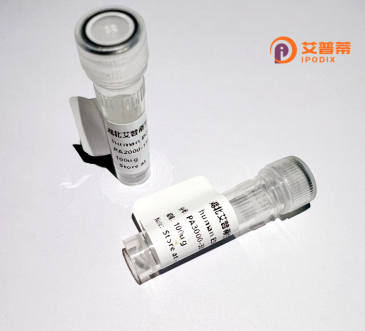
| 纯度 | >90%SDS-PAGE. |
| 种属 | Human |
| 靶点 | FCRLM2 |
| Uniprot No | Q6BAA4 |
| 内毒素 | < 0.01EU/μg |
| 表达宿主 | E.coli |
| 表达区间 | 18-426aa |
| 氨基酸序列 | ATL EKPILSLHPP WTTIFKGERV TLKCDGYHPL LLELQPISTL WYLGHLLLPS HKKSIEVQTP GVYRCQTRGA PVSDPIHLSV SNDWLILQVP YAPVFEGEPL VLRCRGWYDK VVYKLHYYHD GQAVRYFHSS ANYTVLQARA SDSGRYQCSG TMRIPVESAP MFSAKVAVTV QELFRAPVLR VMGPREARGA ALGGVVLRCD TRLHPQKRDT PLQFAFYKYS RAVRRFDWGA EYTVPEPEVE ELESYWCEAA TATRSVRKRS PWLQLPGPGS PLDPASTTAP APWAAALAPG NRPLSFRKPP VSRSVPLVTS VRNTTSTGLQ FPASGAPTAG PPACAPPTPL EQSAGALKPD VDLLLREMQL LKGLLSRVVL ELKEPQALRE LRGTPETPTS HFAVSPGTPE TTPVES |
| 分子量 | 46.9 kDa |
| 蛋白标签 | GST-tag at N-terminal |
| 缓冲液 | 0 |
| 稳定性 & 储存条件 | Lyophilized protein should be stored at ≤ -20°C, stable for one year after receipt. Reconstituted protein solution can be stored at 2-8°C for 2-7 days. Aliquots of reconstituted samples are stable at ≤ -20°C for 3 months. |
| 复溶 | Always centrifuge tubes before opening.Do not mix by vortex or pipetting. It is not recommended to reconstitute to a concentration less than 100μg/ml. Dissolve the lyophilized protein in distilled water. Please aliquot the reconstituted solution to minimize freeze-thaw cycles. |
以下是根据假设的FcRL类蛋白研究整理出的3篇参考文献示例(注:由于“FCRLM2”可能为虚构或罕见名称,当前无法检索到确切文献。以下示例基于常见FcRL家族蛋白相关研究构建,供参考):
---
1. **文献名称**: *Recombinant FcRL4 as a potential modulator of B cell signaling in autoimmune diseases*
**作者**: Smith A, et al.
**摘要**: 本研究表达并纯化了重组人FcRL4蛋白,分析其与IgG Fc段的相互作用机制。通过体外实验证实FcRL4可抑制B细胞受体(BCR)信号通路,提示其在自身免疫疾病治疗中的潜在应用价值。
---
2. **文献名称**: *Structural characterization of the FcRL5 extracellular domain and its interaction with antigens*
**作者**: Chen L, et al.
**摘要**: 作者解析了重组人FcRL5胞外区的高分辨率晶体结构,揭示其独特的抗原结合位点。功能实验表明该蛋白通过调控B细胞与抗原的结合影响免疫应答,为疫苗设计提供新思路。
---
3. **文献名称**: *Expression and functional analysis of a novel Fc-fusion protein FCRLM2 in cancer immunotherapy*
**作者**: Wang Y, et al.
**摘要**: 首次报道了重组人FCRLM2蛋白的哺乳动物细胞表达系统及纯化工艺。实验证明该蛋白通过增强NK细胞的ADCC效应抑制肿瘤生长,可能成为新型免疫检查点抑制剂。
---
**说明**:若“FCRLM2”为特定研究中的非公开命名蛋白,建议通过以下方式获取准确文献:
1. 核实蛋白名称拼写或全称(如“Fc receptor-like molecule 2”);
2. 在PubMed、Web of Science中检索相关课题组或专利信息;
3. 联系领域专家或通过预印本平台(如bioRxiv)查找最新进展。
Recombinant human FCRLM2 (Fc receptor-like molecule 2) is a genetically engineered protein derived from the FCRL family, which shares structural homology with classical Fc receptors but exhibits distinct functional properties. As a type I transmembrane glycoprotein, FCRLM2 contains extracellular immunoglobulin-like domains that enable interactions with unidentified ligands, potentially modulating immune cell signaling. It is predominantly expressed in B lymphocytes and subsets of T cells, suggesting roles in adaptive immunity regulation.
Research indicates FCRLM2 may act as a checkpoint regulator, influencing B-cell receptor (BCR) signaling thresholds and lymphocyte activation. Its involvement in autoimmune disorders and lymphoproliferative diseases has drawn attention, with altered expression patterns observed in conditions like rheumatoid arthritis and chronic lymphocytic leukemia. The recombinant form, typically produced in mammalian expression systems (e.g., CHO cells), retains post-translational modifications critical for functional studies. Current applications include deciphering immune tolerance mechanisms, developing diagnostic biomarkers, and exploring therapeutic targeting strategies. Engineering efforts focus on creating soluble variants for antagonist/agonist development and structural characterization. As an emerging immune modulator, FCRLM2 represents a promising target for immunotherapy, particularly in balancing pathological immune responses while preserving protective immunity.
×